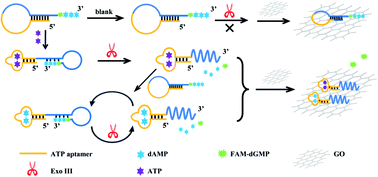A fluorescent aptasensor with product-triggered amplification by exonuclease III digestion for highly sensitive ATP detection†
Abstract
Here we proposed a conceptually new amplified ATP assay by combination of exonuclease III (Exo III) with an allosteric aptasensor triggered by ATP with graphene oxide (GO) assistance. The assay needs only one single fluorophore-labelled DNA probe, which was designed having the fluorescence labelled nucleotide and enzymatic substrate sequence away from the ATP recognition aptamer sequence to avoid the hindrance of the target recognition and enzymatic cleavage. The signal amplification mechanism is based on the binding ability of the produced dAMP to the ATP aptamer. In every cycle, the ATP can trigger the assay probe to be digested by the Exo III. The digestion product includes 3 dAMPs, which also can trigger the assay probe. The limit of detection as low as 31 nM was achieved, which is very competitive compared to those of other aptasensors with a signal amplification strategy for ATP detection. We envision that this principle could facilitate the design and development of other aptamer-based ATP sensors using different nucleases and find their potential applications in biological and environmental fields in the future.



 Please wait while we load your content...
Please wait while we load your content...